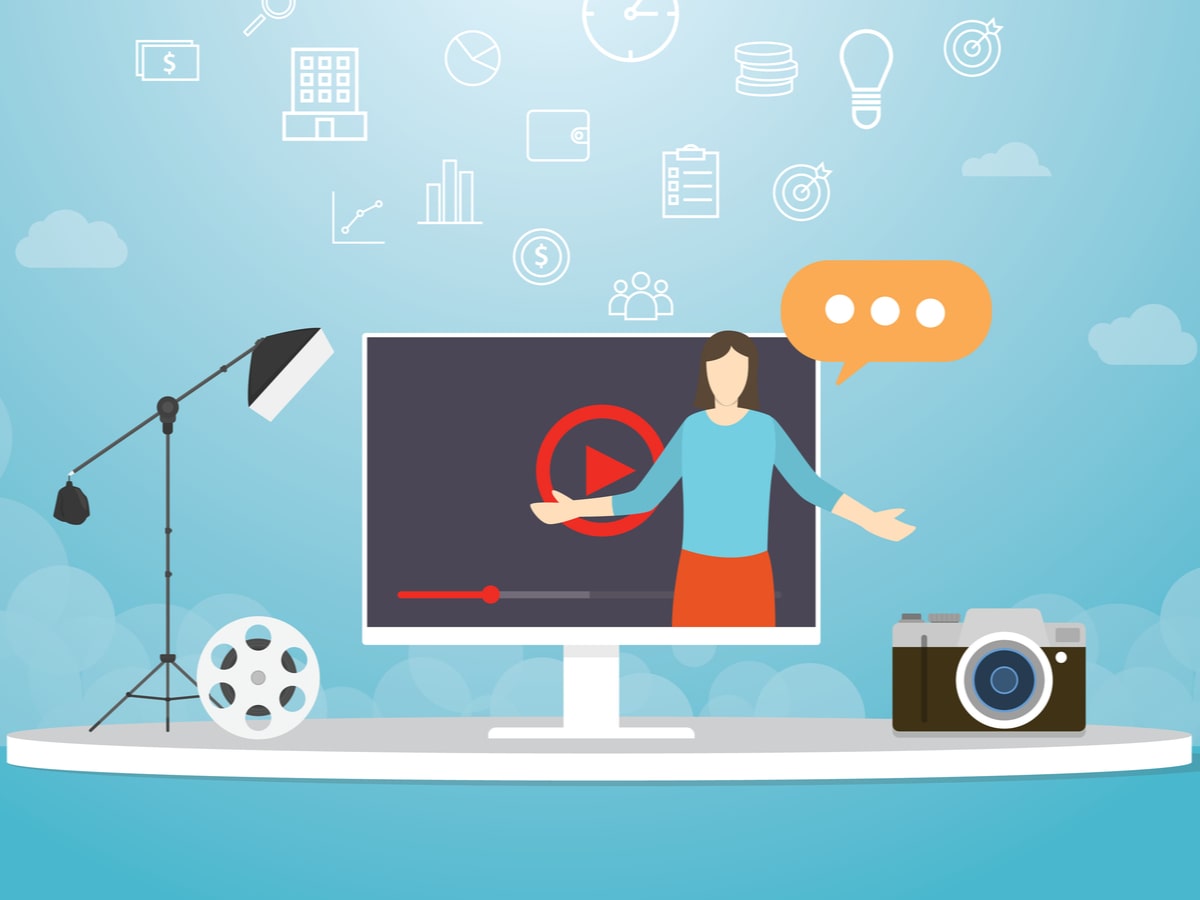OK, you’re thinking about using video for selling products or informing people about something important. You already know that corporate video production with animation is the most popular medium for communications. The big question is: How can you use these powerful tools to achieve your own goals without understanding how they work? Once you know what is an explainer video, you’ll understand how to use it the right way.
In this “idiot’s guide” to business animation, we’ll explore several ways to use it successfully. We’ll also show you examples of high-converting explainers across a wide range of business sectors –
☑ Software
☑ HR
☑ Consumer financial services
☑ Health & wellness
☑ Tourism & travel
We’ll also show you why animated content gives the best ROI, and how to drive your audience into action and increase sales.
The origins of video marketing
Explainers are both informative and entertaining. But where did this good idea of “video explainers” come from?
To see where we’re going, let’s first look at where we’ve been.
The roots of modern animated explainer video methods began with early motion-picture production. In the beginning, sales pitches were crude and obvious.
Today, corporate video production with animation continue to evolve into newer, more effective forms. Old-school marketing doesn’t work anymore.
B2B audiences watch for benefits instead of features
In 2021 and beyond, social media marketing is driving animation trends. The first marketing wave was focused on consumer products, but now B2B is the fastest-growing marketplace.
Instead of pushing features that me-centered consumers don’t care about, today’s successful marketers use lovable cartoon characters to engage audiences and demonstrate their products’ benefits.
Here are 2 examples to compare and see how far this marketing medium has come:
Notice how animation engages the mind and makes the topic more interesting. Compare that modern animation with this “old-school” marketing clip:
Now think about how long it would take human actors to explain complex software topics using only words and physical action…. That’s the power of animation.
Why animation is more effective than live-action video
Over the past few years, the trend has been away from live-action and toward using animated video for marketing purposes. This trend is driven by cost as well as technology.
Using human actors is much more expensive than creating animated characters. The newest generation of explainer video software makes it easier for talented artists to create clips that grip viewers attention and tweak all the right emotions.
Check out these digital special effects:
Viewers see the spatial relationships between problems and solutions in real-time. The moving, animated elements show us exactly how the video’s storyline progresses from problem to solution.
The story is told, the problem is solved, and the benefits are explained, all in less than two and a half minutes. Human actors couldn’t move so fast, and they eat expensive lunches.
Audio + Visual = Better Engagement & Retention –> More Sales
Of course, another reason why animated characters have replaced human actors is simplicity: Complex topics can’t be effectively explained within a short period of time without using powerful animation effects combined with on-screen text and audio voiceover.
Numerous scientific studies have shown that people retain information at least 60% better when they receive it in video format combined with audio.
For example, have a look at this clip aimed at an audience of gene-therapy researchers:
Let’s face the ugliest truth: Some topics are super complex even for professionals in their highly-technical fields. Big-league genetic engineers earn large salaries and their time is very expensive. In that example clip, max ROI means giving those well-paid, easily-bored scientists the maximum data in the minimum time.
It’s all about money, and the value or cost of time. Since time is money, the faster you can explain what your product does, or what you want your audience to do, the more money you’ll earn – or save.
Explainer Video Definition – How do they differ from other types of videos?
The main distinguishing characteristic of an explainer is its length. Videos that are produced purely for entertainment, news, or documentary purposes are always at least several minutes longer. Yet, explainers are always short, usually a couple of minutes of run-time. That’s because explainers focus narrowly on highlighting only one issue, solving only one problem, or educating viewers about a single important idea.
However, the short time frame also means you’ll need to pack a lot of information into a short time. And, the voiceover script needs to match the on-screen action.
That’s why the best animated videos always come from experienced teams. For an example of a high-converting clip, check this out:
The capability of this company’s HR platform is beautifully expressed by the animated characters – Their little faces tell the video’s story so well that we don’t even need to listen to the audio voiceover – the on-screen text repeats the same message.
That’s animation at its finest!
What an animated explainer video is not
Since explainers are so effective, there’s been plenty of hype about the power of video marketing. It’s a highly-effective medium, but we need to keep the right perspective about its limitations.
Explainer ≠ encyclopedia
The main limitation is the scope of your topic: For technical and structural reasons mentioned earlier, explainer videos are always short. That’s why the production must be focused with pinpoint precision on a single narrow topic, and dispensed in short time segments.
So, if you want to paint a big picture, then a single explainer won’t work – You’ll need a long series of short individual videos instead.
If you’re looking to teach a caveman-simple concept in a way that reaches everyone from child to adult, then you should try very short videos or loops.
Here’s an example of a short, repetitive clip that teaches viewers important information about the coronavirus pandemic:
This simple message is so effective because its focus is very narrow.
What are Animated explainer videos?
OK, we’ve looked at the distinctions between explainers and other genres such as entertainment and news. Now let’s dive into several specific classes of explainers, and look at some outstanding examples of each type.
- Whiteboard videos
- Hand drawn videos
- Promotional videos
- Educational videos & tutorials
- Promos & demos
- Blended animation with live-action and/or static images
What are Animated whiteboard videos?
This is the classic type of animation. Animated characters, graphic elements, and text appear on-screen, then disappear as the storyline moves along.
Here’s an example of a high-converting whiteboard-style production:
Notice how the graphic elements explain the topic on-screen, while a voiceover reinforces viewers’ understanding. As mentioned earlier, the informative power of video is based on combining audio with visual input.
With whiteboard animation, audiences remember more of what they learned – That’s why this clip is so successful.
What are Hand drawn Videos?
Likewise, hand-drawn animated videos are even more effective than whiteboard productions. That’s because the
Here are the classic characteristics of a hand drawn video: A white or clear background, and a continuous drawing line.
The story is sketched out on a background. Sometimes the background is represented as a piece of paper, a blank wall, or some other “flat” writing surface.
Usually, there are lines that appear onscreen to show relationships between animated characters and other graphic elements. Here’s a great example:
Notice how the constantly-moving lines keep the eye engaged long enough for a viewer to understand the story. That’s an example of good storytelling combined with great drawing!
What are Educational videos and tutorials?
About half of all explainers are intended for marketing products and services. It’s easier to sell things when you have a slick video to explain their features and benefits to prospective buyers.
On the other hand, many videos are made in the format of tutorials and educational videos. That’s because explainers cost less to train people to perform tasks both simple and complex.
Explainers are cheaper than live trainers
Do you need to teach clients or staff how to do simple repetitive tasks? Try animated characters instead of “live” HR people.
It’s the same problem as using human actors for live-action videos – An organization’s HR staff are too expensive for teaching newbie employees and contractors the same repetitive tasks.
Simple tutorials like that are the workhorses of B2B explainers today. Instead of using costly human labor to teach basic tasks, they use cheap-yet-entertaining videos.
And, if you want to save even more time for your clients and staff, then work with a good animated video explainer agency instead of trying to produce the content yourself.
Promos
To truly understand what is an animated explainer video, just take a look at this high-converting promo:
Did you notice how the creepy hacker character wearing a red hoodie draws attention to the problem of identity theft? He’s scary enough to drive viewers into action, but not so frightening or fake as to turn them off.
If your organization is handling sensitive topics, then use animated characters to spread your message. For example, here’s an informative clip about a women’s health topic:
Well-drawn animated characters can talk about any topic!
Blended animation with live-action
When you’re thinking about using animated videos to explain a concept or teach a task, the best solution is to work with an experienced explainer agency. It’s because only an expert team can produce animation blended with live action video.
As mentioned earlier, combining animation with live video, graphic elements and audio voiceover makes the audience retain more of the information they receive. Better audience retention means higher click-through rates and more sales.
That’s why marketing promos are so popular across all B2B and consumer verticals in 2021.
Demos
Just like other marketing video formats, product and service demonstrations help save time and money for buyers and sellers alike. For example, some companies use demos set up as video loops in high-traffic retail shopping locations.
Likewise, social media marketers use animation to quickly show things like clothing fashions, electronic gadgets, and personalized services to casual online visitors. You can show anything fastest with moving pictures instead of words or static images.
Demos can also be used like this over-the-animated-shoulder tutorial that teaches clients how to fund an invoice using their new software platform:
Takeaways
The effectiveness of animation is driving its use for both video marketing and educational purposes. Animated characters are cheaper than live actors, and they can handle complex topics quickly and easily.
As long as your video focuses on explaining a narrow topic within a short period of time, it can give you a strong ROI. Remember that your results will be based on talent and experience alone.
After reading this guide to business animation, if you’re still wondering what is an explainer video, then you should certainly choose an experienced corporate video production company to work on your project.
Do you have a question about explainer videos? We can help, just contact us now!





